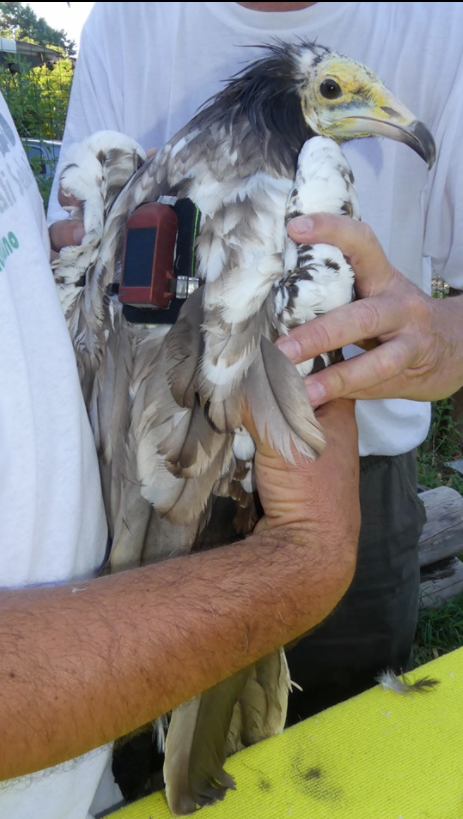
Our Italian colleagues released a total of eight captive-bred Egyptian Vultures in Basilicata between July and August. CERM Association Centro Rapaci Minacciati and ISPRA Istituto Superiore per la Protezione e la Ricerca Ambientale carried out these releases as part of the LIFE Egyptian Vulture project to support the Italian population of this species, which dramatically dropped over the last few years. The vultures were equipped with satellite transmitters to monitor their movements and tackle threats. The Vulture Conservation Foundation provided four of these transmitters.
Releasing the eight Egyptian Vultures
Ahead of their releases, the vultures spent a few days in an aviary located at a strategic position in the park to acclimatise. The team also established a feeding station near the aviary, as well as in other areas that are frequented by young vultures once free. This helps facilitate the adaptation of captive-bred birds into the wild following their release.
Between the end of July and mid-August 2019, eight young Egyptian Vultures were reintroduced in Basilicata, at the Parco Naturale Regionale della Murgia Materana. The first release took place on 29 July, with Francesca, Diego, Jane, Kate, while the second, on 15 August, with Leonardo, Nino, Beatrice and Lucrezia.
One of the birds (Francesca, born in 2017) had to be recaptured in the meantime, because it was not moving much and was not afraid of humans, suggesting some behavioural problems.
Although the CERM Association organised many releases of Egyptian Vultures in southern Italy in the past, never before had such a large number of birds been released in the same year. This was possible thanks to the large number of chicks that were recently hatched at the CERM Centro Rapaci Minacciati, a facility located in southern Tuscany that specialises in the reproduction of this species in captivity and the release in nature of young birds.
Furthermore, the birds released were from three different ages: Leonardo and Nino hatched in May 2019, Diego, Jane and Kate in 2018 and Beatrice, Francesca and Lucrezia in 2017. This is the first time in Italy that Egyptian Vultures from three different age groups were released simultaneously, and it’s the first time it involved birds that were two years old.
Monitoring the vultures

The eight young vultures were equipped with GPS/GSM transmitters ahead of their release and are now being monitored by ISPRA and the CERM Association. The transmitters were provided by ISPRA and us here at the Vulture Conservation Foundation. Some of the young vultures have already started their migration journey to their wintering grounds in sub-Saharan Africa. In the map below you can find the movements of three of the birds, tagged with GPS transmitters provided by the VCF

Tackling threats

The project addresses various threats. E-distribuzione S.p.A. is isolating medium voltage power lines at the release site to minimise the risk of electrocution for large birds of prey which rest on the supports of the lines.
Furthermore, the project aims to prevent poaching. Last year, in the province of Trapani, the young Egyptian Vulture Clara released in Matera in 2018 was killed due to poaching. To prevent another tragedy, the Forest Carabinieri have started an intense surveillance activity in migratory areas where there is a higher risk of illegal killing. To facilitate the work of active patrols in the area, ISPRA and the CERM Association will continuously transmit the positions of the birds detected through their GPS/GSM transmitters.
LIFE Egyptian Vulture

The LIFE Egyptian Vulture project, which is led by E-distribuzione S.p.A., aims to promote the conservation and demographic recovery of the population of the Egyptian Vulture in Italy.
The activities carried out within the LIFE Egyptian Vulture project are part of the biodiversity conservation policies implemented by the European Union and the United Nations (UNEP). The experiences gained in the release of captive-bred vultures will be shared with the international community to promote the conservation of this endangered species at a global level.









